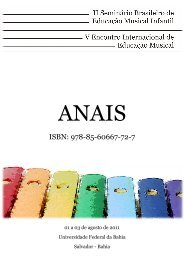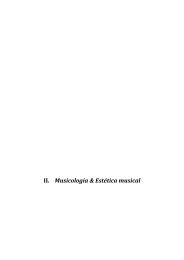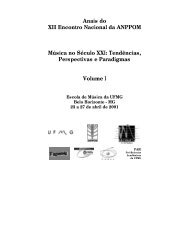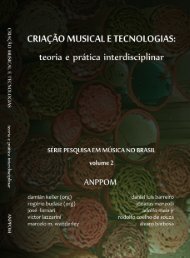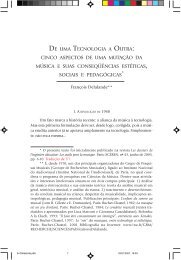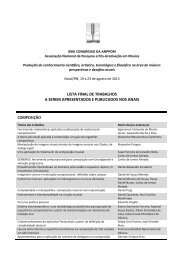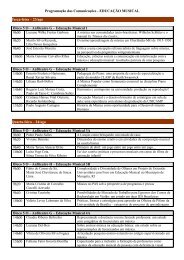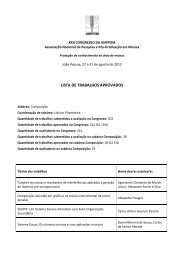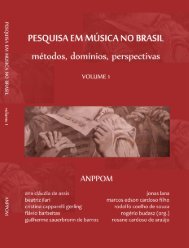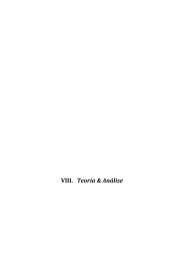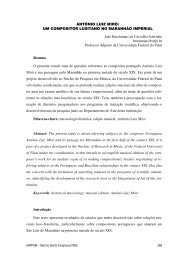download da versão impressa completa em pdf - anppom
download da versão impressa completa em pdf - anppom
download da versão impressa completa em pdf - anppom
You also want an ePaper? Increase the reach of your titles
YUMPU automatically turns print PDFs into web optimized ePapers that Google loves.
Evolutionary Soud Synthesis Controlled by Gestural Data . . . . . . . . . . . . . . . . . . . . . . . . . . . . . .<br />
by pairs of genderless predecessors. Individuals that reach their lifespan time are eliminated<br />
from the Population set. The syst<strong>em</strong> erases their Genotypes, so it will never be repeated<br />
(which would create a clone). While alive, Individuals will generate sound objects whose<br />
perceptual identity is defined by their Genotypes. The sound output of this version of<br />
ESSynth is given by all sound objects generated by the coexistence of all Individuals alive,<br />
within the Population set. In this impl<strong>em</strong>entation, there is no Selection process. Individuals<br />
are only eliminated when their lifespan is over. New individuals are created by the<br />
Reproduction process. This behavior <strong>em</strong>phasizes the syst<strong>em</strong> capacity of generating selforganized<br />
sound structures.<br />
Figure 4 shows the impl<strong>em</strong>entation of the Reproduction process in PD. There are<br />
twelve tables depicted on the top and another six on the bottom. The ones on the top<br />
represent the parents’ Genotypes. The ones on the top left are the genotype of the first<br />
individual. The one on the top right side corresponds to the second individual. These<br />
genotypes are the mappings from the gestural <strong>da</strong>ta (drawings or <strong>da</strong>nce), that are stored in<br />
the gestural matrix. Both gestural <strong>da</strong>ta types have the same genotypical organization of 6<br />
tables for each Individual Genotype, as described in section 3.2. There are two sliders on<br />
the right side of this figure. They represent the rates for crossover and mutation. They<br />
determine how much recombination (crossover) and variance (mutation) the offspring<br />
genotype, shown in the 6 tables at the bottom, will have.<br />
In its first version, ESSynth output was given by a queue of best Individuals (the<br />
waveforms selected by the Selection process) given by the Hausdorff distance between<br />
Population and Target set. In this current impl<strong>em</strong>entation the sound output of ESSynth is<br />
synthesized by all Individuals in the Population set. They act as agents in a self-organized<br />
syst<strong>em</strong>. The sound output is compounded by all unique Individuals coexisting within this<br />
variable-size set. There is a chance that the Population set reduces in size until all Individuals<br />
are extinct. On the other hand, there is also the chance that the Population size grows so<br />
much that the ESSynth computer model crashes. To avoid that, the syst<strong>em</strong> has minimum<br />
and maximum thresholds for the Population size, where it can vary in between.<br />
Reproduction process creates a new Individual through the Genetic Operators:<br />
Crossover and Mutation. Crossover creates a new offspring Genotype from the<br />
recombination of a copy of the Genotypes of its parents. Mutation inserts variability,<br />
through small bits of random information, in the offspring Genotype. These genetic<br />
operators are impl<strong>em</strong>ented in the PD subpatch called “pd genetic operators,” as seen also<br />
in Figure 4. This sub-patch receives two coefficients, given by the pair of vertical sliders, at<br />
the right side of this figure. These are variables normalized from zero to one, where 0<br />
means “no operation,” and value 1 means “full” operation. They can be changed on-the-fly,<br />
146<br />
. . . . . . . . . . . . . . . . . . . . . . . . . . . . . . . . . . . . . . . . . . . . . . . . . . . . . . . . . . . . . . . . . . . . . . . . . . . . . opus



